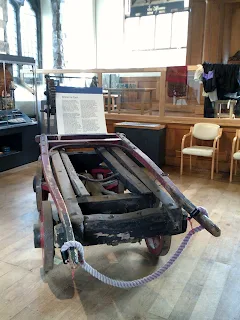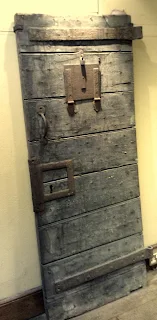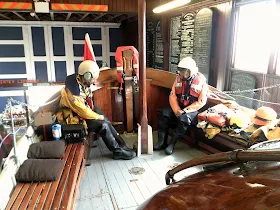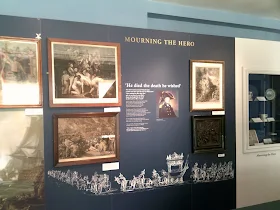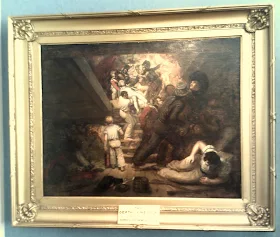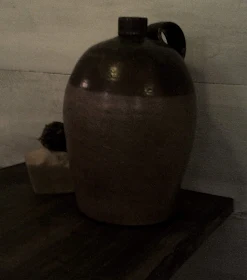So, there's me declaring that I wasn't going to be blogging quite so much, as my MA Creative Writing course is about to start and I need to concentrate on that, but... it hasn't started yet and I visited Great Yarmouth for a short break last week, and it's only fair that I share my pictures with you!😊
Great Yarmouth- often referred to simply as 'Yarmouth'- is sandwiched between the North Sea and the River Yare. Settlement dates back to Roman times and the first of several priories, beginning with the 1101 founding of the Church of St Nicholas, were consecrated in 1119. Great Yarmouth was considered to be a wealthy trading centre, of great importance (due, no doubt, to its prime situation) and was granted a charter (an authority of rights) by King John in 1208. The town was also the recipient of a charter of military jurisdiction, in 1552, by Edward VI. By the early 18th century it was a thriving port with a significant herring industry and, during the French Revolutionary and Napoleonic Wars, was the main supply base town for the North Sea Fleet.
The town suffered Luftwaffe bombing during World War II, but much of the old town survives; including two-thirds of the protective medieval wall and many of the maze of alleys known simply as the 'The Rows', with several of the original 145 remaining. The market place is one of the largest in England and has been operating since the 13th century and the town is served by the Wherry Line- which is classified as a rural line- from Norwich, with Great Yarmouth railway station sitting at its terminus.
The coastline has its main drag, known as 'The Golden Mile', and thousands of holiday makers and day trippers make their way each year to its gorgeous beaches and seafront attractions- although it's fair to say that Yarmouth, like many British seaside towns, is struggling to survive.
I've now been to Great Yarmouth over a dozen times- twice as a kid (with my parents and my youth group), once for a disastrous interview at what was then Great Yarmouth College of Art and eleven times with my SuperDean. Initially, he had to drag me here- it's his childhood haunt, but I was brought up in Norfolk (King's Lynn, to be precise), and certainly have an aversion to that place (although that's to do with my strong dislike of small town minds rather than for the town itself). But I found that I quite like Yarmouth, and also Norwich, which we also sometimes visit. They are on the other side of Norfolk, after all! I've been back for breaks of either a week at a time or just a few days and make the most of this town, which is easy to reach by train from east London, where I currently reside.
We usually stay in Caister and, if it's distant history that interests you then you might like my blog about local Caister Roman Fort:-
https://elainerockett.blogspot.com/2018/10/miss-elaineous-visits-caister-roman-fort.html
We also took a trip to Burgh Castle, which is now only a ruin, last year. It does, however offer up some fantastic views over the Norfolk Broads. Read all about it in my blog post here:-
https://elainerockett.blogspot.com/2018/10/miss-elaineous-visits-burgh-castle.html
Our first stop off was the Tolhouse Gaol. Originally a 12th century medieval merchant's house, it passed into the hands of the town officials and its long association with the law began. It was a pleasure to visit this historical attraction as it's not always open.
The first room in the building has served as a courtroom for various different types of court...
Standing on the judiciary platform looking out over the courtroom...
In this section sits a Brewers' Cart...
...These were actually too wide to fit down The Rows, so a special cart known as a Troll Cart was developed to transport goods along them. Today, there is a pub/ hotel in town called The Troll Cart.
Bailiffs' Chest...
You can play the role of the judge and have to make sure the punishment fits the crime.
I elongated myself to my fullest height and passed sentence upon Dean- I told him he stood accused of making me stand my round and, as a punishment, he had to buy ALL the drinks throughout our short break. Gavel banged! Sentence passed! (He chose to ignore my legal status and demands...)😁
Judges' wigs are available for dressing up- I tried one on and commented that I'd joined the Brian May appreciation society...
Market Place, 1796, by John Butcher.
The displays tell you about different types of prisoner...
...With a little about traditions over the ages...
You learn more about the Tolhouse as a court, and get to see some quite gruesome restraints.
In the next room you learn about the different experiences of rich and poor prisoners 200 years ago...
This cabinet questions what a typical crook would have been like. This room also features details of noted local prison reformer, Sarah Martin (1791-1843).
Prisoners' chains...
Heavy door. This building also once served as a police station.
This isn't the first time we've visited the museum. We were lucky enough to get a private visit a few years back, and were allowed to venture down this trapdoor into the old holding cells below. The cells themselves are divided into two sections- one for the poor, but another for prisoners who possessed the coin that allowed them an easier life with privileges; such as better food, freedom from restraining chains, and visitors (which could well include not just family but also 'ladies of the night'...)
This official-looking desk and chair may have been used by whomever was in charge of the prisoners.
This door contains the stairway up to the courtroom...
It is presumed that it was built in the middle of the 16th century.
Dean in the notorious dungeon, known as 'The Hold'. Damn, I wasn't fast enough with the keys- he got out!😉
Cell doors branch off to the right. The museum also includes descriptions of former prisoners, their crimes and their punishments.
Empty cell...
Male prisoner next door...
...And a female prisoner next door to him...
You can wander into this cell and, believe me, it's very oppressive.
Looking out of the cell...
Prisoners' rations. The prisoners were given jobs to do, and these included unwinding junk (old rope once used on ships) to create oakum, which was used for mixing with tar and plugging holes in ships' decks.
The original steps upwards to the courtroom...
You can just about make them out as you peer upwards.
I had to crouch at a very odd angle to get this shot...
The next day we took ourselves off to the coastal area and visited the Venetian Waterways. They've had a major overhaul, and I took many photos of them last year, when it was all a work in progress. Read all about that in my previous blog post:- https://elainerockett.blogspot.com/2018/05/miss-elaineous-visits-venetian.html
The Heritage Lottery Fund released £1.7 million in funding...
Beautiful sundial detailing...
A lot of care has been taken over the placing of plants and shrubs...
It was an overcast but warm day...
The project is still a work in progress...
But the result so far is very easy on the eye, and unmistakably elegant...
Black-eyed Susans sprouting out from this border...
Major work has been undertaken on the structures...
An offset garden with another little sundial...
These adornments might be modern, but they certainly capture the tranquil and classic mood of this section of Great Yarmouth.
You can hire a pedal boat...
But I declined. If I'm going to be going out in a boat, give me one with an engine. I'm not pedalling the bloody thing myself!
We walked up the promenade to Britannia Pier. The original pier lasted from 1858-1899, but was demolished following storm damage and a ship's collision. A replacement 810 foot pier opened in 1901 but the present pavilion dates from 1958. The pier theatre is very much thriving; with live music acts and comedians such as Roy Chubby Brown and Sarah Millican putting in an appearance.
Donkey rides were available on the beach. Here, the donkeys are showing me their bums!😄
Donkeys tethered at their feeding stations. They were totally uninterested in me!
The view from Britannia Pier, looking over the vast expanse of what is actually a very good beach.
We wandered into town, and down Victoria Arcade. I love this traditional walkway, and it's such a shame that most of the units are empty. Landlords and the council, sort it out!
Grumpies is a little cafe. If you pop in, be sure to try their delicious cornflake and jam tart: it's just like you use to get at school!
Bubblegum Boutique used to be in the Victoria Arcade but is now down one of the rows. It's my favourite shop in town and stocks quirky, individualistic clothing, shoes and jewellery. Here's the beautiful bow necklace I bought from there during my most recent visit. It's by a Brighton-based designer called Lovett and Co.

The Fishermen's Hospital stands on the east side of the Market Square and was founded in 1702, for 20 old and 'decayed' fishermen and their wives.
Nowadays it has been converted into private residences.
The next day we popped up to Caister Lifeboat, and our walk to get there took us through Caister Cemetery, where the nine men killed during a rescue mission, known as the Beauchamp disaster of 1901, are buried. This memorial proudly stands resplendent as a dedication to the brave victims. Their individual plaques are displayed in accordance with their positions in the doomed craft.
This cast head sits beside a plaque dedicated to all the brave Caister lifeboatmen who have lost their lives in service at the station since 1845. There were more before this date as well, as performing this role has always put life and limb at risk.
This unusual object is an old donation box. The first records of the Caister Beach Company date back to 1791, although their main mission then was salvage. Caister Lifeboat was aghast when, in 1969, the re-organisation of RNLI stations around the coast meant the decommissioning of Caister.
They have run as a voluntary organisation since then. The Shirley Jean Adye was retired to display duties in 1986, and you can climb aboard her. The boats tend to be named after those who've donated the most money towards them.
Caister Lifeboat runs entirely on donations, bequests and capital gained through fundraising and investments.
The driving position. We like to show our support by popping in for coffee and cake, taking a look at their little charity shop and slinging a couple of quid into the tin.
At the end is a very realistic mock-up of the men out at sea on a rescue mission, and you can dress up in the lifeboatmen's kit if you like.
Peering down into the engine room...
Looking over from the lifeboat plinth to historical models of previous lifeboats.
The inquest into the deaths of the 1901 Beauchamp victims resulted in an answer that was later translated by journalists into the now famous phrase 'Caister men never turn back'.
Prince Philip is not the only royal to have visited Caister Lifeboat- Princesses Anne and Alexandra have offered their support, along with Charles and Camilla.
In the shed, and comedian Jim Davidson is a big supporter of Caister Lifeboat.
...As was local turkey farmer Bernard Mathews (1930-2010), who has the distinction of having this lifeboat named after him.
Later, we made our way along the historic waterfront.
Admiral Horatio Nelson (1758-1805) is known as Norfolk's most famous son, and the Nelson Museum is dedicated to his life and achievements.
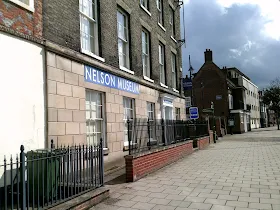
Nelson was born nearby, in Burnham Thorpe, and this classic portrait marks the start of the room devoted to his naval career.
Nelson depicted as a small boy...
A history lesson, and some of Nelson's famous quotes feature on this display.
I have only one eye, I have a right to be blind sometimes... I really do not see the signal!
Nautical knots...
Trinket cabinet...
The Battle of Trafalgar...
Desperate affairs require desperate remedies.
The death of a hero...
Trafalgar commemorative cabinet...
Long view of this small room...
Nelson dying...
Our country will, I believe, sooner forgive an officer for attacking an enemy than for letting it alone.
More memorabilia...
Details of the birth of Nelson's Column. After his death, people became obsessed with him, due to his unique blend of character and personality.
H.M.S. Agamemnon. Nelson was initially disappointed with this ship, but later declared her greatness! It was whilst on this ship that Nelson lost sight of his right eye.
No captain can do very wrong if he places his ship alongside that of the enemy.
One feature of the museum is this mock-up of life on board a ship...
You can see the Vain Old Tart reflected in the end mirror, as well as SuperDean's beer gut to the left!😁
Down the barrel of a gun...
The sailors slept in hammocks like these...
Food rationing on board. Many of the barrels of biscuits contained weevils, which are not harmful to humans and can be ingested along with the food they've infested. Nice!
This is a rather dark photo, which I had to tweak, but can you see the mouse on the cheese behind the jar? Ships' cats weren't just included on the staff as pets, and played a much-needed role.
Fact wall displaying the types of sailors employed to keep the ship running...
The garden is quite spacious and offers a play area for children...
...And adults, too. Dean had a go at playing quoits...
Decorative yet symbolic rigging gracing the wall. I'm sorry, and I know I'm bad, but I couldn't help but think of the bawdy drinking song 'Friggin' In The Riggin'' when I saw this!
Nelson writing a letter. He lost his right arm in the battle of Santa Cruz, in Tenerife, in 1797.
Gentlemen, when the enemy is committed to a mistake we must not interrupt him too soon.
The bed is a recreation of Nelson's four poster bed in the George Inn, Portsmouth, but the bed hangings are the originals.
A cabinet dedicated to Nelson's personal life...
Nelson lost the sight in his right eye in 1794. Contrary to popular belief, he never wore an eye patch.

Ladies' fashions of the day set the mood in this section of the exhibition...

Emma, Lady Hamilton, was Nelson's mistress and the mother of his daughter, Horatia.
She was something of a muse and the story of her life makes for very interesting reading. She was considered to be the great love of Nelson's life.
These items belonged to Nelson's wife, Frances (known as Fanny). The marriage was not a success and he chose Lady Hamilton over her.

Thank God, I have done my duty.
The museum opened in 2002, but, sadly, is set to close at the end of October this year- which is why we made a point of having one last visit (we've been before).
Privately run, the decision was reached after the museum had seen declining visitor numbers and the council removed its funding.
Bust of Nelson.
It is the only museum in the UK devoted entirely to a man who was so proud to come from Norfolk. As its quite a small display- really only filling three rooms- maybe a larger museum could incorporate everything into its own collection? (I'm thinking the National Maritime Museum in Greenwich.) Just a thought!
On the way down, and viewing the garden from the window. It's a shame this place is soon to be no more as it offers up something unique.
Just behind the main waterfront is Greyfriars' Cloisters, which are the remains of a 13th century Franciscan friary. Access is only available via a guided tour, which I've never done. Mind you, a tour would be nice but I can see plenty through the railings!
The entrance hallway to the very classy Quayside Plaza, which is a restaurant with Ferailles situated behind it. Ferailles is an authentic ethic/ oriental homewares and jewellery shop, with an emphasis on fair trade.

The Lydia Eva is the last surviving steam drifter of Great Yarmouth's herring fishing fleet. It is open to visitors but we didn't bother to pop on board as time was limited and we'd clambered all over this attraction before.
Another place we didn't visit was the Elizabethan House Museum, again due to time restraints. It has strong connections to Oliver Cromwell and allegedly contains the room where the death sentence of Charles I was decided upon, as well as a Victorian kitchen and a rather cute little garden.
I do remember, from previous visits, that photos were not allowed, so this is a PDF of one of their works of art which caught my eye. I do love full moons in paintings (no, I don't mean of the 'pants down' variety!)
This is called South Walsham Broad by Moonlight, by Stephen John Batchelder (1849-1932).
I also didn't visit the Time and Tide Museum, which tells the story of Great Yarmouth, and also its herring industry. The last time we went they were showing a rather engaging temporary exhibition about the Titanic. I've written a little about it in this previous blog here, and also added a paragraph with regard to the aforementioned Caister Lifeboat. Click on the link and see my modelling monkey, named Charlie the Chocolate Magic Monkey, and get some idea of how crazy I am!😁
As I mentioned before, most of the time we stay in Caister, and here's a view of the beach. You can see the Scroby Sands wind farm of 30 generators on the horizon. Nowadays, wind power contributes 18% of UK electricity generation.
For those of you who are familiar with my Facebook account, my cover photo of pretty stones was taken on Caister beach five years ago. I took it before I learnt how to turn off the date indicator on my camera!
On our last day we walked through St George's Park, where fishy sculptures mark one entrance. They are herrings, and this arch was inspired by Great Yarmouth's history. You can just about make out the War Memorial to the left.
Ah, the building that was once Great Yarmouth College of Art: scene of my first ever interview. It wasn't a wonderful day and I didn't get accepted onto my chosen course. I wasn't overly impressed with the college as it was, literally, falling to bits, and shut less than ten years later.
My thoughts on my non-acceptance? Oh well- it was their loss.

The Eastern Counties bus station, where I caught my connection to Norwich, once sat right here. It wasn't much of a station- more a turning point. I've mentioned it on an online forum, but no-one seems to remember it. Strange!
(Note: I've since learnt that I got this totally wrong- the old Eastern Counties bus station was actually next to the other Great Yarmouth College of Art annex, on St Peter's Road. This must have been just a bus stop.)
Front view of the college. I have managed to sneak inside before (well, if people will leave the main doors unlocked...) but I no longer have the photographs as they were taken on an old phone. It was a bit of a nostalgia nosey, but there wasn't much to see apart from the stairs as it's private flats now; after sitting derelict for over a decade.
We made our way to Marine Parade (the main seafront drag) and the Winter Gardens have been left to rot and sit derelict. Shipped from Torquay in 1903, this elegant structure has been closed since 2008. In 2018 it was listed as one of the top ten most endangered important buildings of the Victorian/ Edwardian era. It is hoped that the council can attract a commercial partner and it is indicated that, if this comes to fruition, Heritage Lottery Fund money could well become available. I do hope this is the case. Next time I'm in Yarmouth, I'm going to see if it's possible to sneak in and have a nosey....😉
Standing on Wellington Pier- which dates back to 1853- and looking over the beach to Brittania Pier in the distance.
Looking over to the Pleasure Beach and beyond to Power Station Beach...
A lonely sea craft making its way along the water...
The seaward end was restored with major steelwork renovations in 1971, and I take it the restoration didn't include this derelict section...
Looking down onto this 'lost' part of the pier...
We have popped into the Merrivale Model Village before- on one of their their £1 entry days. It was okay, but on that particular day it was way too wet and miserable to do anything more than just walk through.
In the Merrivale Tea Rooms, and I like to indulge in a Norfolk Shortcake...
The award-winning tea rooms with the big fat swede of the SuperDean in the way! Incidentally, using the term 'swede' to describe a head is a Norfolk saying...
The Pleasure Beach in the distance, and you can see the big drop of the Log Flume. It uses sea water, and the basin the ride sits in is metal- which makes the water look most uninviting and like that of a cesspit. Still, it didn't stop me from venturing on it and getting a soaking...
The Pleasure Beach is worth visiting for the Roller Coaster- also known as the Scenic Railway- alone. Dating back to 1932, it is a wooden Grade II listed building. To the right of the picture you can see the hole through which the Monorail passes...
...Fantasy section as you ride the Monorail through the Scenic Railway...
Looking down from the Monorail to the newly-opened Premier Inn. Nelson's Monument is the spike to the right of the photo and was built between 1817-1819. It is a dedication to the local naval hero and is 144 ft (44 m) high. The top can be reached by 217 steps.
I had to take a picture of this diner as we left Caister. I have eaten here before and their brekkies are pretty damn good.💓
We returned to Norwich on one of their new FLIRT trains. All credits to the SuperDean, as he took this photo (being the trainspotting geek that he is...😉)
I have some time off in February, so might pop up to Great Yarmouth for a few days then, saying in a town centre hotel or B&B. It will make a pleasant change as we usually stay at holiday centres, which have evening entertainment included- that is great, but it means that come evening we're ensconced there, and never get to see Golden Mile seafront at night.
I'm looking forward to that (for me) totally new experience.
TTFN
The Miss Elaineous
XXXXXXXXXXXXXXXXXXXX
XXXXX
XXX
X





